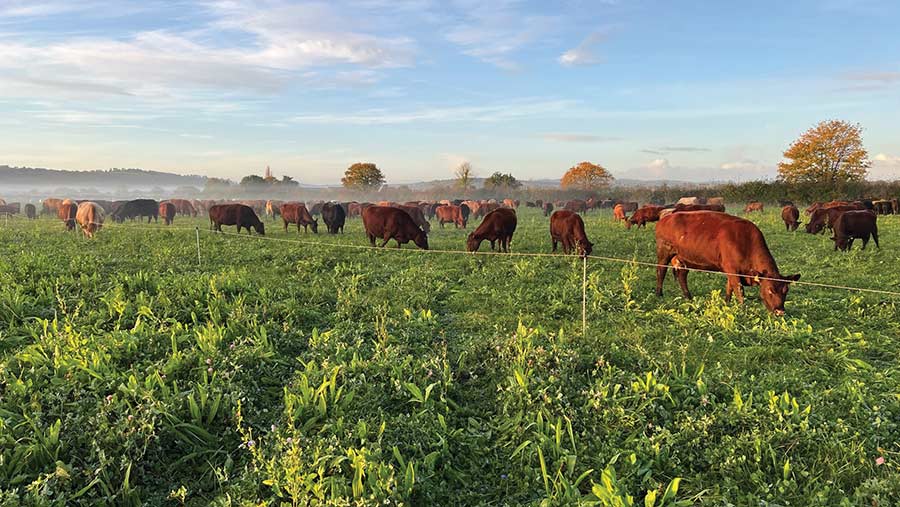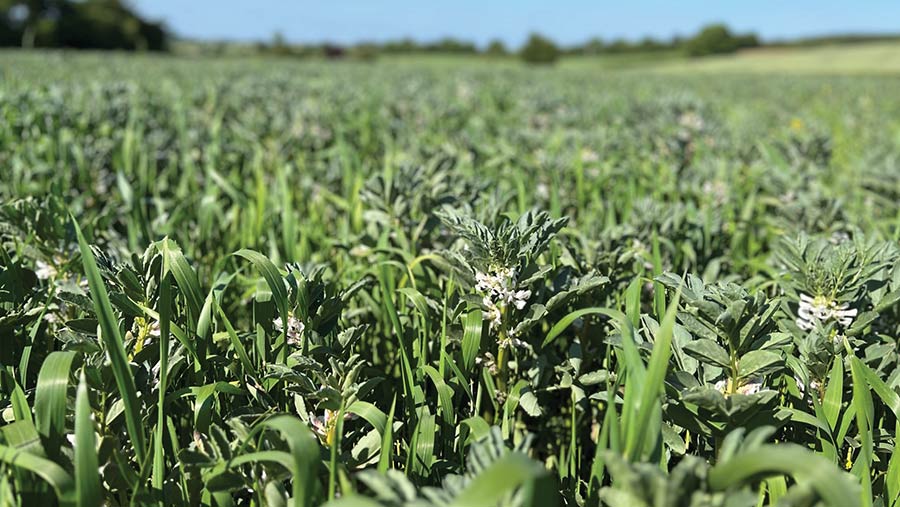Herbal leys and bicrops help hit organic wheat milling premium
 © George Greed
© George Greed Devon farmer George Greed is successfully using herbal leys, inter-crops and population wheats to hit organic milling premiums, as part of his nature friendly farming operation which has increased arable profits by 24%.
George’s nature focus began 10 years ago when he returned to the family beef and arable farm near Exeter, and began cutting fertiliser and pesticide use to tackle diminishing returns and plateauing crop yields.
“I think farmers have become reliant on artificial inputs. As farmers, we often fear trying different things, but I’ve always found it good to be different and make systems as simple yet effective as possible,” he says.
See also: Herbal leys help halve nitrogen fertiliser use for wheat
All 250ha at Fortescue Farm now receives zero fertiliser and pesticide inputs and last year became certified as organic.
The arable and beef enterprises have been fully integrated, in a “game-changing” rotation based on mob-grazed herbal leys, followed by a wheat and bean bicrop.
George grows two varieties of population wheats for the organic milling market, with 100% of his wheat area intercropped with beans to hit protein specs.
“For me, farming with nature is all about integrating livestock, cropping and the environment together, where each system complements another.”
Farm facts: Fortescue farm
- 250ha farm
- 150ha arable rotation 80ha permanent grassland
- 125 suckler herd and followers
- Sandy clay loam soils
First steps
The first step towards a more nature-based farming system was dropping nitrogen rates and adding humic and fulvic acids to the mix to aid nutrient uptake and crop development.
Insecticides were then eliminated and fungicide sprays scaled back.
Min-till establishment was rolled out across the farm a decade ago, but George quickly realised he was using more and more glyphosate to spray off crops – which didn’t sit right.
Resorting back to traditional cultivations such as discing and shallow ploughing seemed more fitting. Which is why converting the farm to organic was a logical move.
However, George notes the biggest game changer was integrating the 125-cow suckler herd and herbal lays into the arable rotation.
The species-rich leys include: red and white clover, an array of grasses, chicory, plantain and birdsfoot trefoil.
“We previously kept the beef and arable separate – other than spreading manure – but grazing herbal leys transformed our soils in just two-and-a-half years. Soil nutrients are cycling and biology is thriving.
We now see many more insect and bird species with groups of starlings following the cattle when bale grazing.”

© George Greed
Population wheat and bean bicrops
Looking to maximise returns across the arable enterprise, George switched to organic farming to target the human consumption market, rather than growing conventional feed wheat.
“I did not intend to go organic, it just seemed the natural next step. We were already dropping inputs and our grass-fed beef enterprise was pretty much already organic, so the arable area followed.”
Two population wheat varieties are now grown on the farm: a winter wheat called YQ (Yield and Quality) and a spring wheat known as Mariagertoba, which achieves highs of 16% protein when intercropped with spring beans.
Population wheats are genetically diverse varieties from a range of different parentages, which makes them more robust and resilient to unpredictable environmental conditions such as disease pressure and weather.
The YQ wheat population was developed by crossing 20 different varieties at Wakelyns Agroforestry by Prof Martin Wolfe and the Organic Research Centre to combine both yield and quality traits.
Mariagertoba, on the other hand, is a hard red spring wheat population known for high protein content and gluten index.
Bred from 15 different parent varieties by Danish plant breeder Anders Borgen, it is resistant to rust and common bunt.
The wheats are grown as part of the Southwest Grain Network Cann Mills project which involves a group of farmers, millers and bakers producing local, nutritious flour in a working water mill in Shaftesbury, Dorset.
Benefits of bicropping
Growing the wheat with a bicrop of beans comfortably achieves an average of 12.5% protein, when previous monoculture wheats would usually achieve just 10%.
The high protein Mariagertoba with highs of 16% is blended with the lower protein content YQ .
This year’s grain showcased both good yield and quality, hitting Hagberg and protein specifications. The bicrop generated a total yield of 4.5t/ha split equally between wheat and beans.
“I don’t like the perception of organic farming being low input. We’re lowering inputs, but still trying to maximise output as much as we can,” says George.
Diversity in the cropping system is a massive positive which is why all cereals are now intercropped with a legume.
“The large plant density suppresses weeds and if there is lower germination rate of one crop, the other will compensate.
“What’s more, the wheat and beans are full of life, with an array of bees, butterflies and other pollinators,” explains George.
He continues: “Finding the right seed rate is key.”
A standard wheat seed rate of 180kg/ha and a maximum of 75% of a standard bean rate is used, aiming for 18-19 plants/sq m for winter beans and 25 plants/sq m for spring beans.
“Be careful with beans as they can dominate the wheat. If you go with an equal split of each the beans can quickly overtake,” he says.
Crops are separated using a Law Denis gravity separator which can be a slow process particularly when there is a high volume of beans, but it does the trick.
George is looking forward to increasing his area to 40ha of the Mariagertoba and 45ha of ÝQ across the home farm and share farming agreement with neighbouring Whiddon Farm this season.
He plans to continue increasing arable profits across the farm.
George also grows a bicrop of spring oats and peas destined for a local pig feed market. Crops are sown at a full rate of peas, but a reduced rate of oats as these can often be vigorous.
“Peas and oats are great weed suppressors and the oats help the peas stand up. Bicropping is key for organic systems as it adds so much diversity.”
Herbal leys payments and organic wheat trial
A hefty Mid Tier Stewardship scheme is in place at Fortescue Farm, Devon and organic farmer George Greed will be starting his sustainable farming incentive (SFI) application in January next year.
His herbal leys pay £115/ha a year under OP4 in Countryside Stewardship, but will pay the same in SAM3 under SFI.
He also makes the most out of planting winter bird food on awkward field corners and margins, creating habitats on the farm, but also making field work passes simpler to operate.
George is also taking part in a live wheat variety trial investigating a selection of modern wheat varieties’ adaptability to organic systems.
Nelson, Mayflower, YQ, Extase and a population wheat called Oakfarm are being put to the test.
Intercropping benefits
Intercropping wheat and beans provides the following benefits at Fortescue Farm:
- Weed suppression
- Disease control
- Improved protein content of wheat
- Targets the premium organic milling market
- Crops alive with bees, butterflies and other beneficial insects
- Takes the risk out of growing the crop
- Reduces risk of pest attack
- Eliminates artificial inputs

